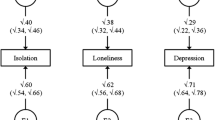Abstract
This study investigates family environments associated with depressive symptoms among male and female runaway adolescents. Data were collected on 197 participants recruited from a runaway youth shelter in the southwest. Regression analyses showed that females’ depressive symptoms were predominately related to interpersonal relationships, such as family communication, conflict, and worry about these relationships. Male participants were particularly sensitive to father’s alcohol abuse and worry about family relationships. Identifying family factors associated with depressive symptoms among male and female runaway youth has implications for treatment and reunification of adolescents with their families.
Similar content being viewed by others
References
Angold, A., Erkanli, A., Silberg, J., Eaves, L., & Costello, E. (2002). Depression scale scores of 817-year-olds: Effects of age and gender. Journal of Child Psychology and Psychiatry, 43(8), 1052–1063.
Avison, W. R., & McAlpine, D. D. (1992). Gender differences in symptoms of depression among adolescents. Journal of Health and Social Behavior, 33(June), 77–96.
Ayerst, S. (1999). Depression and stress in street youth. Adolescence, 34(135), 567–576.
Beam, M., Gil-Rivas, V., Greenburger, E., & Chen, C. (2002). Adolescent problem behavior and depressed mood: Risk and protection within and across social contexts. Journal of Youth and Adolescence, 31(5), 343–357.
Briere, J. (1996). Trauma symptoms checklist for children (TSCC): Professional annual. Lutz, FL: Psychological Assessment Resources, Inc.
Compas, B. E., Oppedisano, G., Connor, J. K., Gerhardt, C. A., Hinen, B. R., Achenbach, T. M., et al. (1997). Gender differences in depressive symptoms in adolescence: Comparison of national samples of clinically referred and nonreferred youths. Journal of Consulting and Clinical Psychology, 65(4), 617–626.
Conger, R. D., Conger, K. J., Elder, G. H., Jr., Lorenz, F. O., Simmons, R. L., & Whitbeck, L. B. (1992). A family process model of economic hardship and adjustment of early adolescent boys. Child Development, 63(3), 526–541.
Crawford, T. N., Cohen, P., Midlarsky, E., & Brook, J. S. (2001). Internalizing symptoms in adolescents: Gender differences in vulnerability to parental distress and discord. Journal of Research on Adolescence, 11(1), 95–118.
DeMan, A., Dolan, D., Pelletier, R., & Reid, C. (1994). Adolescent running away behavior: Active or passive avoidance? Journal of Genetic Psychology, 155(1), 59–64.
Downy, G., & Walker, E. (1992). Distinguishing family-level and child-level influences on development of depression and aggression in children at risk. Development and Psychopathology, 4(1), 81–95.
Ge, X., Lorenz, F., Conger, R., Elder, G., & Simmons, R. (1994). Trajectories of stressful life events and depressive symptoms during adolescence. Developmental Psychology, 30, 467–483.
Gore, S., Aseltine, R. H., & Colten, M. E. (1993). Gender, social-relational involvement, and depression. Journal of Research on Adolescence, 3(2), 101–125.
Grant, R. (1991). The special needs of homeless children: Early intervention at a welfare hotel. Topics in Early Childhood Special Education, 10(4), 76–91.
Grant, K. E., Lyon, A. L., Finkelstein, J. S., Conway, K. M., Reynolds, L. K., O’Koon, J. H., et al. (2004). Gender differences in rates of depressive symptoms among low-income, urban, African American youth: A test of two mediational hypotheses. Journal of Youth and Adolescence, 33(6), 523–533.
Greene, J. M., & Ringwalt, C. L. (1997). Substance use among runaway and homeless youth in three national samples. American Journal of Public Health, 87(2), 229–236.
Hardy, M. A. (1993). Regression with dummy variables. Newbury Park, CA: Sage Publications.
Kessler, R. C., Avenevoli, S., & Merikangas, K. R. (2001). Mood disorders in children and adolescents: An epidemiologic perspective. Society of Biological Psychiatry, 49, 1002–1014.
Kurtz, P., Jarvis, S. V., & Kurtz, G. L. (1991). Problems of homeless youths: Empirical findings and human services issues. Social Work, 36(4), 309–314.
Leadbeater, B. J., Blatt, S. J., & Quinlan, D. M. (1995). Gender-linked vulnerabilities to depressive symptoms, stress, and problem behaviors in adolescents. Journal of Research on Adolescence, 5(1), 1–29.
Martin, G., Bergen, H. A., Richardson, A. S., Roeger, L., & Allison, S. (2004). Sexual abuse and suicidality: Gender differences in a large community sample of adolescents. Child Abuse and Neglect, 28, 491–503.
Mertler, C. A., & Vannatta, R. A. (2005). Advanced and multivariate statistical methods (3rd ed.). Glendale, CA: Pyrczak Publishing.
Nolen-Hoeksema, S. (1994). An interactive model for the emergence of gender differences in depression in adolescence. Journal of Research on Adolescence, 4(4), 519–534.
Rotheram-Borus, M. J. (1993). Suicidal behavior and risk factors among runaway youths. American Journal of Psychiatry, 150(1), 103–107.
Safyer, A. E., Thompson, S. J., Maccio, E., Zittel-Palamara, K., & Forehand, G. (2004). Adolescent and parent perceptions of runaway behavior: Problems and solutions. Child and Adolescent Social Work Journal, 21(5), 493–510.
Schweitzer, R. D., Hier, S. J., & Terry, D. J. (1994). Parental bonding, family systems, and environmental predictors of adolescent homelessness. Journal of Emotional & Behavioral Disorders, 2(1), 39–45.
Sher, K. J., Gershuny, B. S., Peterson, L., & Raskin, G. (1997). The role of childhood stressors in the intergenerational transmission of alcohol use disorders. Journal of Studies on Alcohol, 58(4), 414–427.
Smart, R. G., & Walsh, G. W. (1993). Predictors of depression in street youth. Adolescence, 28(109), 41–53.
Tavitian, M., Lubiner, J., Green, L., Grebstein, L., & Velicer, W. (1987). Dimensions of family functioning. Journal of Social Behavior and Personality, 2, 191–204.
Thompson, S. J., Maguin, E., & Pollio, D. E. (2003). National and regional differences among runaway youth using federally funded crisis shelters. Journal of Social Service Research, 30(1), 1–17.
Whitbeck, L., Hoyt, D., & Ackley, K. (1997). Abusive family backgrounds and later victimization among runaway and homeless adolescents. Journal of Research on Adolescence, 7(4), 375–392.
Whitbeck, L. B., Hoyt, D. R., & Bao, W.-N. (2000). Depressive symptoms and co-occurring depressive symptoms, substance abuse, and conduct problems among runaway and homeless adolescents. Child Development, 71(3), 721–732.
Yoder, K. (1999). Comparing suicide attempters, suicide ideators, and nonsuicidal homeless and runaway adolescents. Suicide and Life-Threatening Behavior, 29(1), 25–35.
Author information
Authors and Affiliations
Corresponding author
Rights and permissions
About this article
Cite this article
Thompson, S.J., Bender, K. & Kim, J. Family Factors as Predictors of Depression Among Runaway Youth: Do Males and Females Differ?. Child Adolesc Soc Work J 28, 35–48 (2011). https://doi.org/10.1007/s10560-010-0218-5
Published:
Issue Date:
DOI: https://doi.org/10.1007/s10560-010-0218-5




